Case Study: Respiratory and Cardiovascular Health Issues Analysis
VerifiedAdded on 2022/10/14
|11
|2825
|12
Case Study
AI Summary
This case study focuses on Mr. C, a 64-year-old faculty member presenting with headache, weakness, and numbness, with a history of hypertension and a possible transient ischemic attack. The assignment delves into the assessment of subjective and objective data, relevant national guidelines, and necessary diagnostic tests such as nerve conduction tests and electrocardiograms. It explores the need for consultations with specialists like cardiologists and neurologists, along with the medical and nursing diagnoses. Legal and ethical considerations, the plan of care involving medical, nursing, and complementary therapies, and the application of Healthy People 2020 objectives are also discussed. Furthermore, the case study emphasizes the importance of patient education and the use of CPT codes for billing, providing a comprehensive overview of patient management in cases of respiratory and cardiovascular complaints. The assignment also highlights the importance of a circle of care, involving various healthcare professionals to ensure comprehensive patient care.
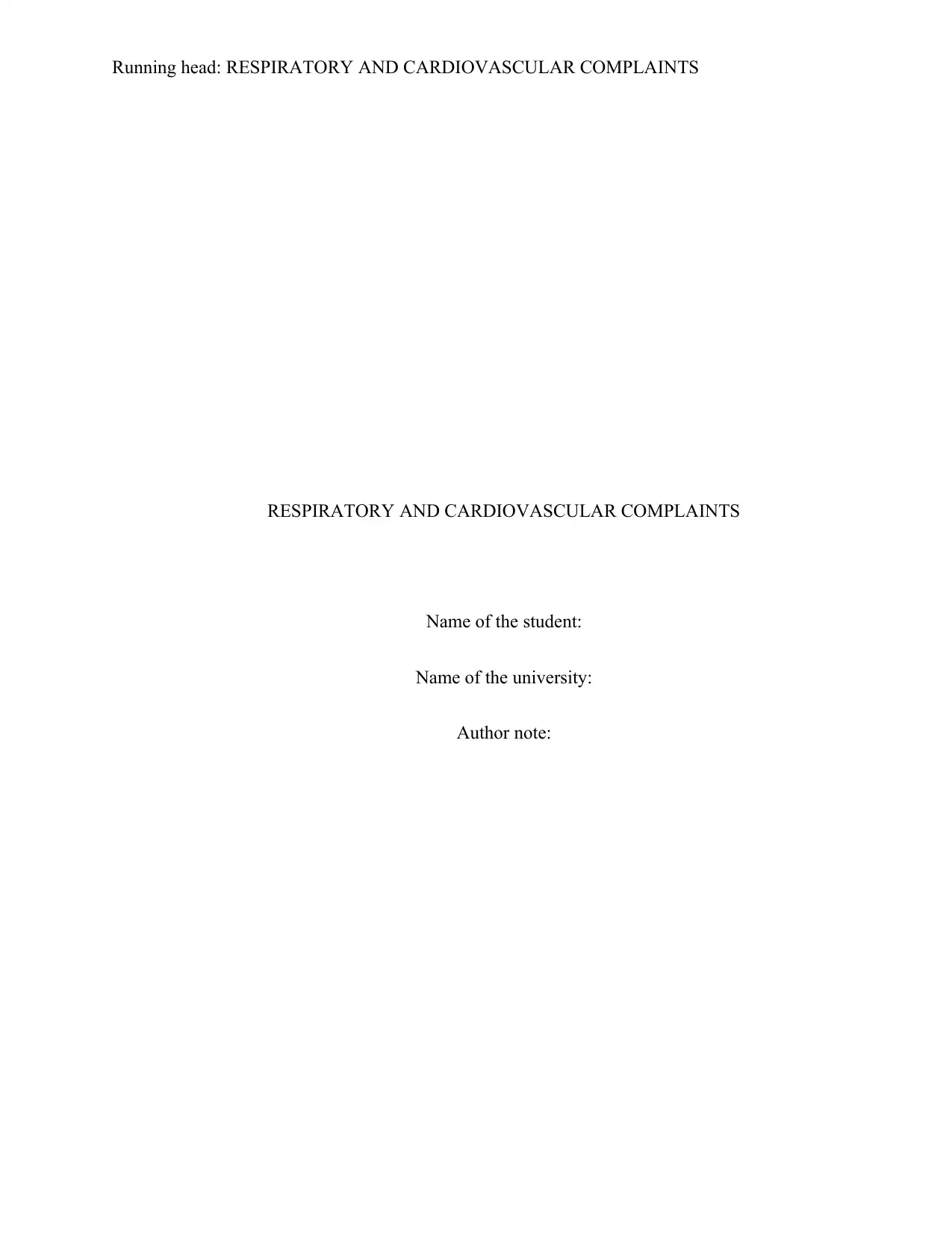
Running head: RESPIRATORY AND CARDIOVASCULAR COMPLAINTS
RESPIRATORY AND CARDIOVASCULAR COMPLAINTS
Name of the student:
Name of the university:
Author note:
RESPIRATORY AND CARDIOVASCULAR COMPLAINTS
Name of the student:
Name of the university:
Author note:
Paraphrase This Document
Need a fresh take? Get an instant paraphrase of this document with our AI Paraphraser
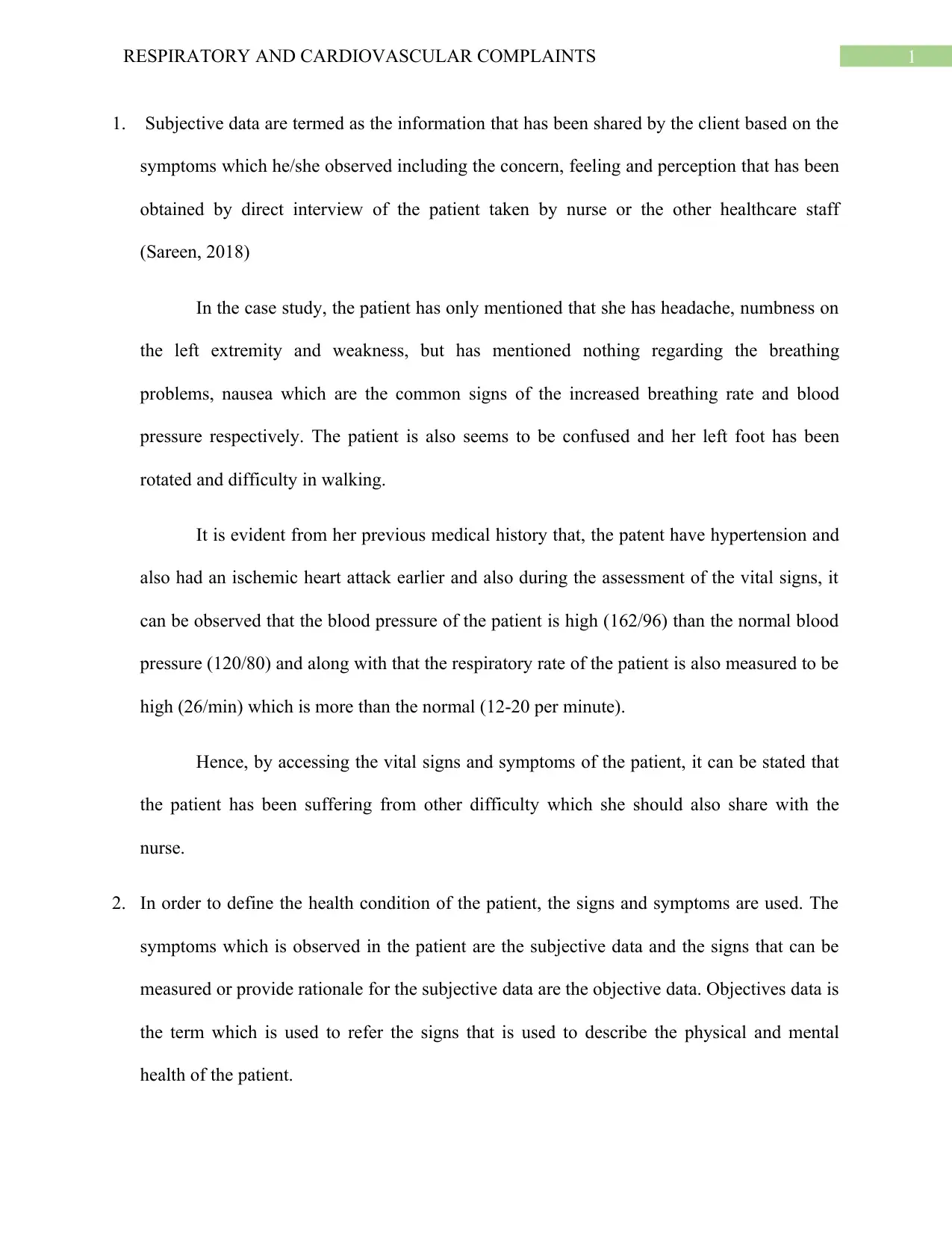
1RESPIRATORY AND CARDIOVASCULAR COMPLAINTS
1. Subjective data are termed as the information that has been shared by the client based on the
symptoms which he/she observed including the concern, feeling and perception that has been
obtained by direct interview of the patient taken by nurse or the other healthcare staff
(Sareen, 2018)
In the case study, the patient has only mentioned that she has headache, numbness on
the left extremity and weakness, but has mentioned nothing regarding the breathing
problems, nausea which are the common signs of the increased breathing rate and blood
pressure respectively. The patient is also seems to be confused and her left foot has been
rotated and difficulty in walking.
It is evident from her previous medical history that, the patent have hypertension and
also had an ischemic heart attack earlier and also during the assessment of the vital signs, it
can be observed that the blood pressure of the patient is high (162/96) than the normal blood
pressure (120/80) and along with that the respiratory rate of the patient is also measured to be
high (26/min) which is more than the normal (12-20 per minute).
Hence, by accessing the vital signs and symptoms of the patient, it can be stated that
the patient has been suffering from other difficulty which she should also share with the
nurse.
2. In order to define the health condition of the patient, the signs and symptoms are used. The
symptoms which is observed in the patient are the subjective data and the signs that can be
measured or provide rationale for the subjective data are the objective data. Objectives data is
the term which is used to refer the signs that is used to describe the physical and mental
health of the patient.
1. Subjective data are termed as the information that has been shared by the client based on the
symptoms which he/she observed including the concern, feeling and perception that has been
obtained by direct interview of the patient taken by nurse or the other healthcare staff
(Sareen, 2018)
In the case study, the patient has only mentioned that she has headache, numbness on
the left extremity and weakness, but has mentioned nothing regarding the breathing
problems, nausea which are the common signs of the increased breathing rate and blood
pressure respectively. The patient is also seems to be confused and her left foot has been
rotated and difficulty in walking.
It is evident from her previous medical history that, the patent have hypertension and
also had an ischemic heart attack earlier and also during the assessment of the vital signs, it
can be observed that the blood pressure of the patient is high (162/96) than the normal blood
pressure (120/80) and along with that the respiratory rate of the patient is also measured to be
high (26/min) which is more than the normal (12-20 per minute).
Hence, by accessing the vital signs and symptoms of the patient, it can be stated that
the patient has been suffering from other difficulty which she should also share with the
nurse.
2. In order to define the health condition of the patient, the signs and symptoms are used. The
symptoms which is observed in the patient are the subjective data and the signs that can be
measured or provide rationale for the subjective data are the objective data. Objectives data is
the term which is used to refer the signs that is used to describe the physical and mental
health of the patient.
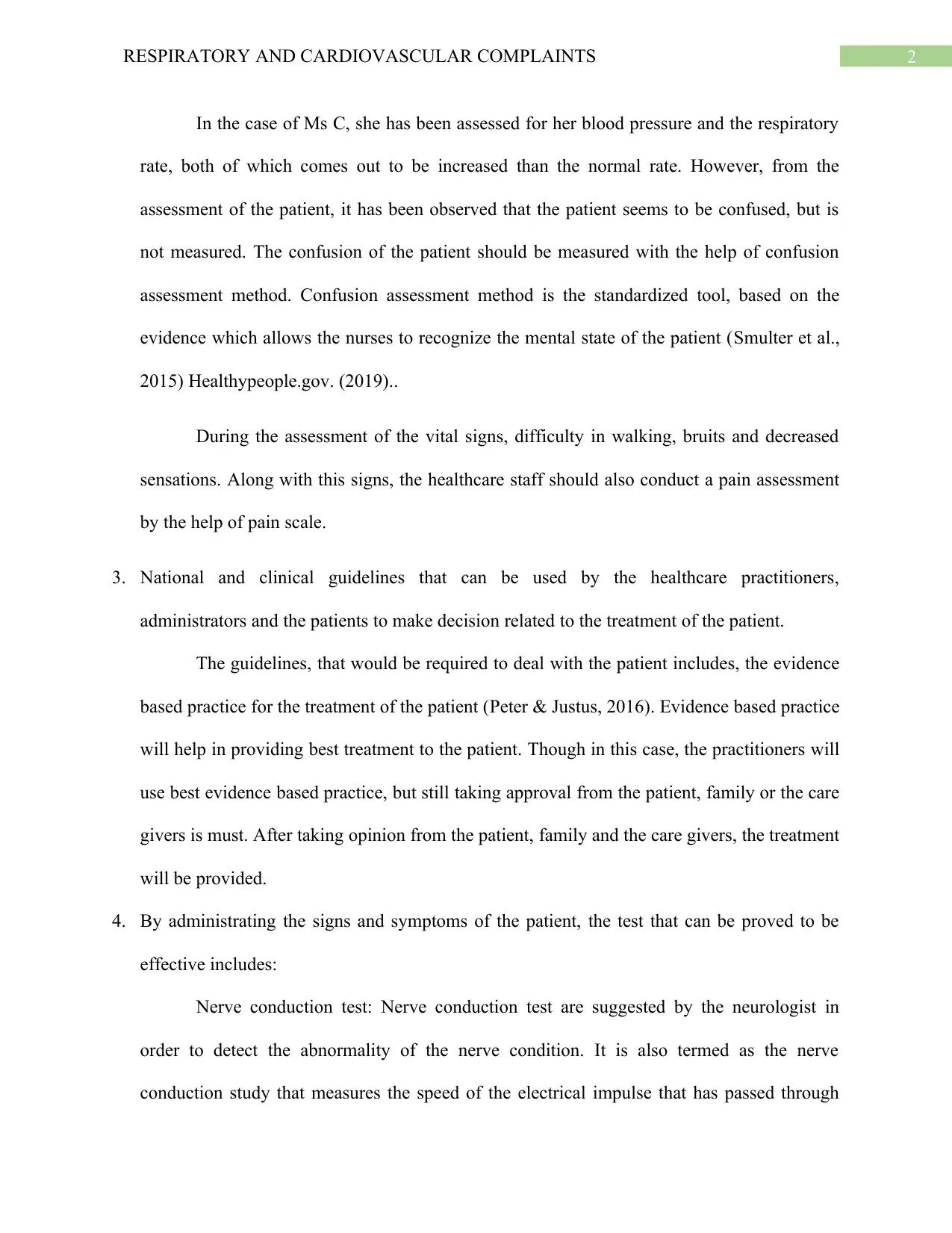
2RESPIRATORY AND CARDIOVASCULAR COMPLAINTS
In the case of Ms C, she has been assessed for her blood pressure and the respiratory
rate, both of which comes out to be increased than the normal rate. However, from the
assessment of the patient, it has been observed that the patient seems to be confused, but is
not measured. The confusion of the patient should be measured with the help of confusion
assessment method. Confusion assessment method is the standardized tool, based on the
evidence which allows the nurses to recognize the mental state of the patient (Smulter et al.,
2015) Healthypeople.gov. (2019)..
During the assessment of the vital signs, difficulty in walking, bruits and decreased
sensations. Along with this signs, the healthcare staff should also conduct a pain assessment
by the help of pain scale.
3. National and clinical guidelines that can be used by the healthcare practitioners,
administrators and the patients to make decision related to the treatment of the patient.
The guidelines, that would be required to deal with the patient includes, the evidence
based practice for the treatment of the patient (Peter & Justus, 2016). Evidence based practice
will help in providing best treatment to the patient. Though in this case, the practitioners will
use best evidence based practice, but still taking approval from the patient, family or the care
givers is must. After taking opinion from the patient, family and the care givers, the treatment
will be provided.
4. By administrating the signs and symptoms of the patient, the test that can be proved to be
effective includes:
Nerve conduction test: Nerve conduction test are suggested by the neurologist in
order to detect the abnormality of the nerve condition. It is also termed as the nerve
conduction study that measures the speed of the electrical impulse that has passed through
In the case of Ms C, she has been assessed for her blood pressure and the respiratory
rate, both of which comes out to be increased than the normal rate. However, from the
assessment of the patient, it has been observed that the patient seems to be confused, but is
not measured. The confusion of the patient should be measured with the help of confusion
assessment method. Confusion assessment method is the standardized tool, based on the
evidence which allows the nurses to recognize the mental state of the patient (Smulter et al.,
2015) Healthypeople.gov. (2019)..
During the assessment of the vital signs, difficulty in walking, bruits and decreased
sensations. Along with this signs, the healthcare staff should also conduct a pain assessment
by the help of pain scale.
3. National and clinical guidelines that can be used by the healthcare practitioners,
administrators and the patients to make decision related to the treatment of the patient.
The guidelines, that would be required to deal with the patient includes, the evidence
based practice for the treatment of the patient (Peter & Justus, 2016). Evidence based practice
will help in providing best treatment to the patient. Though in this case, the practitioners will
use best evidence based practice, but still taking approval from the patient, family or the care
givers is must. After taking opinion from the patient, family and the care givers, the treatment
will be provided.
4. By administrating the signs and symptoms of the patient, the test that can be proved to be
effective includes:
Nerve conduction test: Nerve conduction test are suggested by the neurologist in
order to detect the abnormality of the nerve condition. It is also termed as the nerve
conduction study that measures the speed of the electrical impulse that has passed through
⊘ This is a preview!⊘
Do you want full access?
Subscribe today to unlock all pages.

Trusted by 1+ million students worldwide
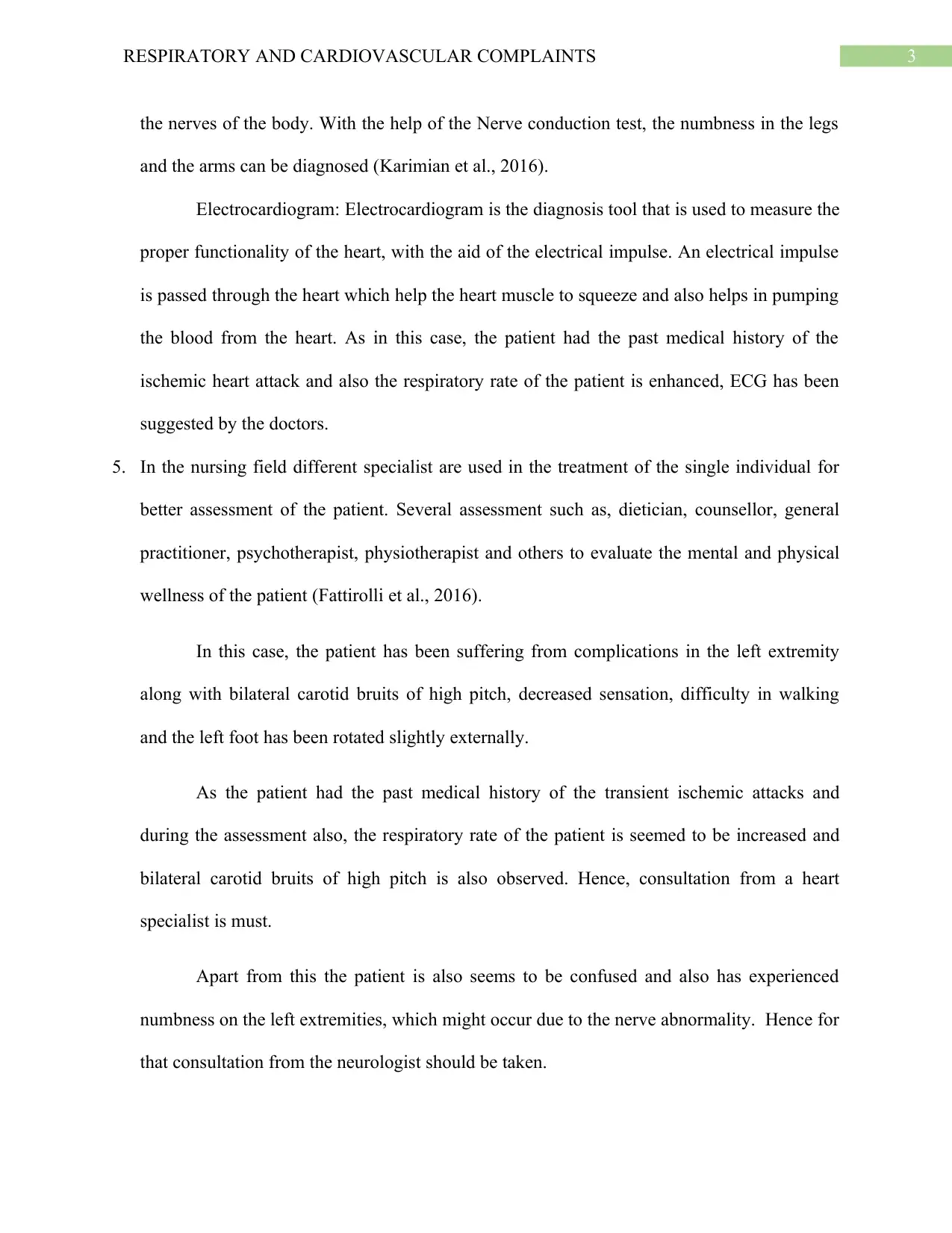
3RESPIRATORY AND CARDIOVASCULAR COMPLAINTS
the nerves of the body. With the help of the Nerve conduction test, the numbness in the legs
and the arms can be diagnosed (Karimian et al., 2016).
Electrocardiogram: Electrocardiogram is the diagnosis tool that is used to measure the
proper functionality of the heart, with the aid of the electrical impulse. An electrical impulse
is passed through the heart which help the heart muscle to squeeze and also helps in pumping
the blood from the heart. As in this case, the patient had the past medical history of the
ischemic heart attack and also the respiratory rate of the patient is enhanced, ECG has been
suggested by the doctors.
5. In the nursing field different specialist are used in the treatment of the single individual for
better assessment of the patient. Several assessment such as, dietician, counsellor, general
practitioner, psychotherapist, physiotherapist and others to evaluate the mental and physical
wellness of the patient (Fattirolli et al., 2016).
In this case, the patient has been suffering from complications in the left extremity
along with bilateral carotid bruits of high pitch, decreased sensation, difficulty in walking
and the left foot has been rotated slightly externally.
As the patient had the past medical history of the transient ischemic attacks and
during the assessment also, the respiratory rate of the patient is seemed to be increased and
bilateral carotid bruits of high pitch is also observed. Hence, consultation from a heart
specialist is must.
Apart from this the patient is also seems to be confused and also has experienced
numbness on the left extremities, which might occur due to the nerve abnormality. Hence for
that consultation from the neurologist should be taken.
the nerves of the body. With the help of the Nerve conduction test, the numbness in the legs
and the arms can be diagnosed (Karimian et al., 2016).
Electrocardiogram: Electrocardiogram is the diagnosis tool that is used to measure the
proper functionality of the heart, with the aid of the electrical impulse. An electrical impulse
is passed through the heart which help the heart muscle to squeeze and also helps in pumping
the blood from the heart. As in this case, the patient had the past medical history of the
ischemic heart attack and also the respiratory rate of the patient is enhanced, ECG has been
suggested by the doctors.
5. In the nursing field different specialist are used in the treatment of the single individual for
better assessment of the patient. Several assessment such as, dietician, counsellor, general
practitioner, psychotherapist, physiotherapist and others to evaluate the mental and physical
wellness of the patient (Fattirolli et al., 2016).
In this case, the patient has been suffering from complications in the left extremity
along with bilateral carotid bruits of high pitch, decreased sensation, difficulty in walking
and the left foot has been rotated slightly externally.
As the patient had the past medical history of the transient ischemic attacks and
during the assessment also, the respiratory rate of the patient is seemed to be increased and
bilateral carotid bruits of high pitch is also observed. Hence, consultation from a heart
specialist is must.
Apart from this the patient is also seems to be confused and also has experienced
numbness on the left extremities, which might occur due to the nerve abnormality. Hence for
that consultation from the neurologist should be taken.
Paraphrase This Document
Need a fresh take? Get an instant paraphrase of this document with our AI Paraphraser
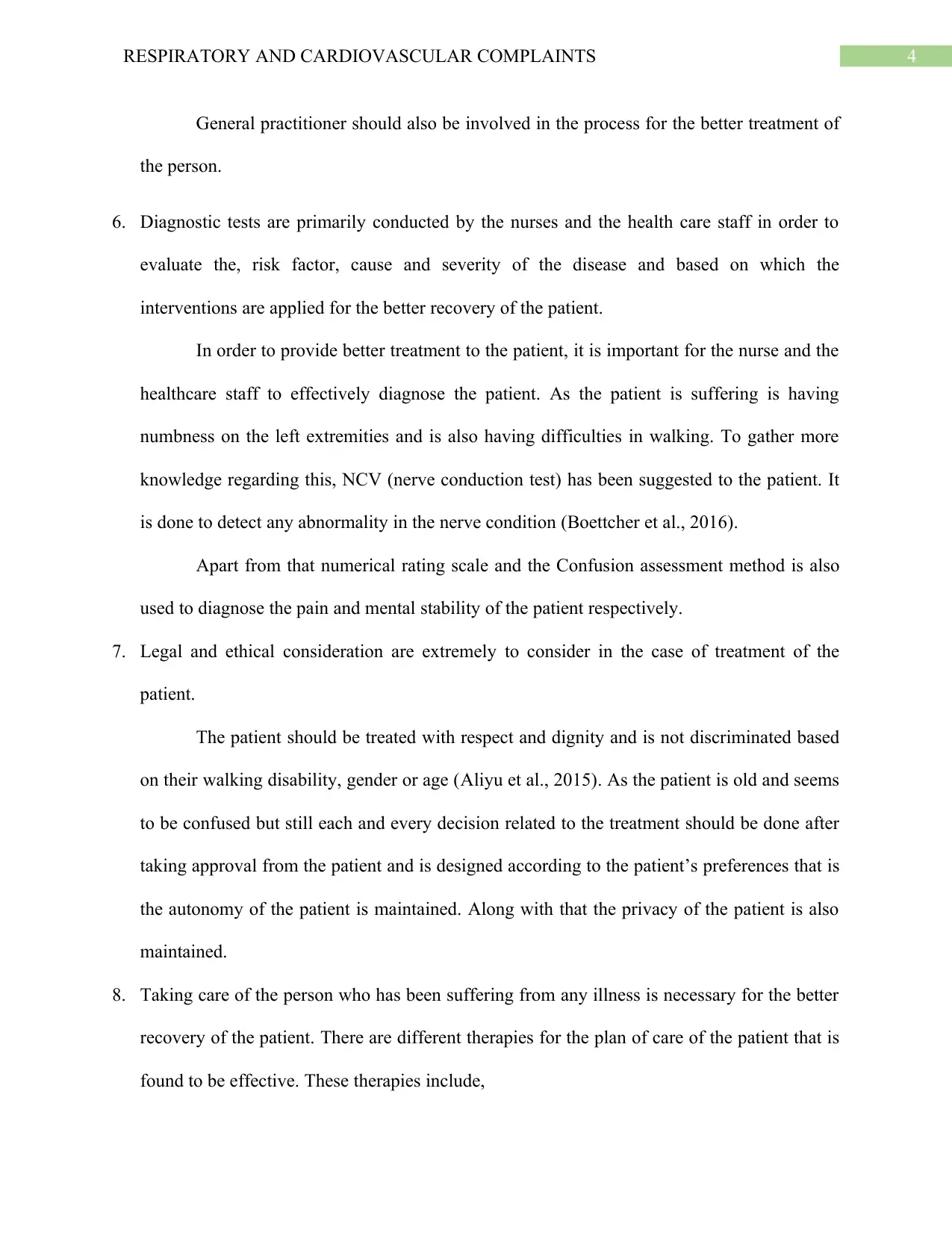
4RESPIRATORY AND CARDIOVASCULAR COMPLAINTS
General practitioner should also be involved in the process for the better treatment of
the person.
6. Diagnostic tests are primarily conducted by the nurses and the health care staff in order to
evaluate the, risk factor, cause and severity of the disease and based on which the
interventions are applied for the better recovery of the patient.
In order to provide better treatment to the patient, it is important for the nurse and the
healthcare staff to effectively diagnose the patient. As the patient is suffering is having
numbness on the left extremities and is also having difficulties in walking. To gather more
knowledge regarding this, NCV (nerve conduction test) has been suggested to the patient. It
is done to detect any abnormality in the nerve condition (Boettcher et al., 2016).
Apart from that numerical rating scale and the Confusion assessment method is also
used to diagnose the pain and mental stability of the patient respectively.
7. Legal and ethical consideration are extremely to consider in the case of treatment of the
patient.
The patient should be treated with respect and dignity and is not discriminated based
on their walking disability, gender or age (Aliyu et al., 2015). As the patient is old and seems
to be confused but still each and every decision related to the treatment should be done after
taking approval from the patient and is designed according to the patient’s preferences that is
the autonomy of the patient is maintained. Along with that the privacy of the patient is also
maintained.
8. Taking care of the person who has been suffering from any illness is necessary for the better
recovery of the patient. There are different therapies for the plan of care of the patient that is
found to be effective. These therapies include,
General practitioner should also be involved in the process for the better treatment of
the person.
6. Diagnostic tests are primarily conducted by the nurses and the health care staff in order to
evaluate the, risk factor, cause and severity of the disease and based on which the
interventions are applied for the better recovery of the patient.
In order to provide better treatment to the patient, it is important for the nurse and the
healthcare staff to effectively diagnose the patient. As the patient is suffering is having
numbness on the left extremities and is also having difficulties in walking. To gather more
knowledge regarding this, NCV (nerve conduction test) has been suggested to the patient. It
is done to detect any abnormality in the nerve condition (Boettcher et al., 2016).
Apart from that numerical rating scale and the Confusion assessment method is also
used to diagnose the pain and mental stability of the patient respectively.
7. Legal and ethical consideration are extremely to consider in the case of treatment of the
patient.
The patient should be treated with respect and dignity and is not discriminated based
on their walking disability, gender or age (Aliyu et al., 2015). As the patient is old and seems
to be confused but still each and every decision related to the treatment should be done after
taking approval from the patient and is designed according to the patient’s preferences that is
the autonomy of the patient is maintained. Along with that the privacy of the patient is also
maintained.
8. Taking care of the person who has been suffering from any illness is necessary for the better
recovery of the patient. There are different therapies for the plan of care of the patient that is
found to be effective. These therapies include,
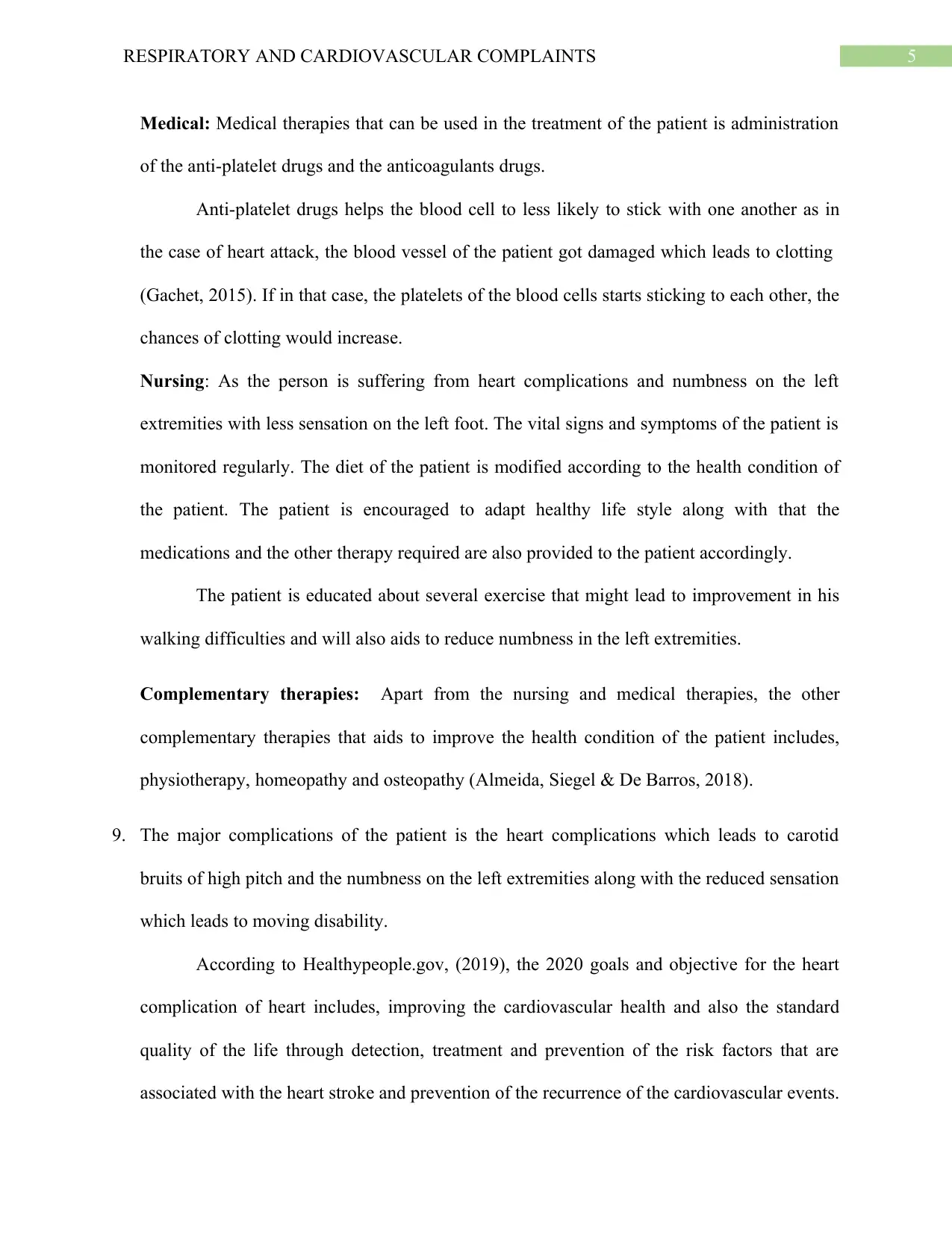
5RESPIRATORY AND CARDIOVASCULAR COMPLAINTS
Medical: Medical therapies that can be used in the treatment of the patient is administration
of the anti-platelet drugs and the anticoagulants drugs.
Anti-platelet drugs helps the blood cell to less likely to stick with one another as in
the case of heart attack, the blood vessel of the patient got damaged which leads to clotting
(Gachet, 2015). If in that case, the platelets of the blood cells starts sticking to each other, the
chances of clotting would increase.
Nursing: As the person is suffering from heart complications and numbness on the left
extremities with less sensation on the left foot. The vital signs and symptoms of the patient is
monitored regularly. The diet of the patient is modified according to the health condition of
the patient. The patient is encouraged to adapt healthy life style along with that the
medications and the other therapy required are also provided to the patient accordingly.
The patient is educated about several exercise that might lead to improvement in his
walking difficulties and will also aids to reduce numbness in the left extremities.
Complementary therapies: Apart from the nursing and medical therapies, the other
complementary therapies that aids to improve the health condition of the patient includes,
physiotherapy, homeopathy and osteopathy (Almeida, Siegel & De Barros, 2018).
9. The major complications of the patient is the heart complications which leads to carotid
bruits of high pitch and the numbness on the left extremities along with the reduced sensation
which leads to moving disability.
According to Healthypeople.gov, (2019), the 2020 goals and objective for the heart
complication of heart includes, improving the cardiovascular health and also the standard
quality of the life through detection, treatment and prevention of the risk factors that are
associated with the heart stroke and prevention of the recurrence of the cardiovascular events.
Medical: Medical therapies that can be used in the treatment of the patient is administration
of the anti-platelet drugs and the anticoagulants drugs.
Anti-platelet drugs helps the blood cell to less likely to stick with one another as in
the case of heart attack, the blood vessel of the patient got damaged which leads to clotting
(Gachet, 2015). If in that case, the platelets of the blood cells starts sticking to each other, the
chances of clotting would increase.
Nursing: As the person is suffering from heart complications and numbness on the left
extremities with less sensation on the left foot. The vital signs and symptoms of the patient is
monitored regularly. The diet of the patient is modified according to the health condition of
the patient. The patient is encouraged to adapt healthy life style along with that the
medications and the other therapy required are also provided to the patient accordingly.
The patient is educated about several exercise that might lead to improvement in his
walking difficulties and will also aids to reduce numbness in the left extremities.
Complementary therapies: Apart from the nursing and medical therapies, the other
complementary therapies that aids to improve the health condition of the patient includes,
physiotherapy, homeopathy and osteopathy (Almeida, Siegel & De Barros, 2018).
9. The major complications of the patient is the heart complications which leads to carotid
bruits of high pitch and the numbness on the left extremities along with the reduced sensation
which leads to moving disability.
According to Healthypeople.gov, (2019), the 2020 goals and objective for the heart
complication of heart includes, improving the cardiovascular health and also the standard
quality of the life through detection, treatment and prevention of the risk factors that are
associated with the heart stroke and prevention of the recurrence of the cardiovascular events.
⊘ This is a preview!⊘
Do you want full access?
Subscribe today to unlock all pages.

Trusted by 1+ million students worldwide
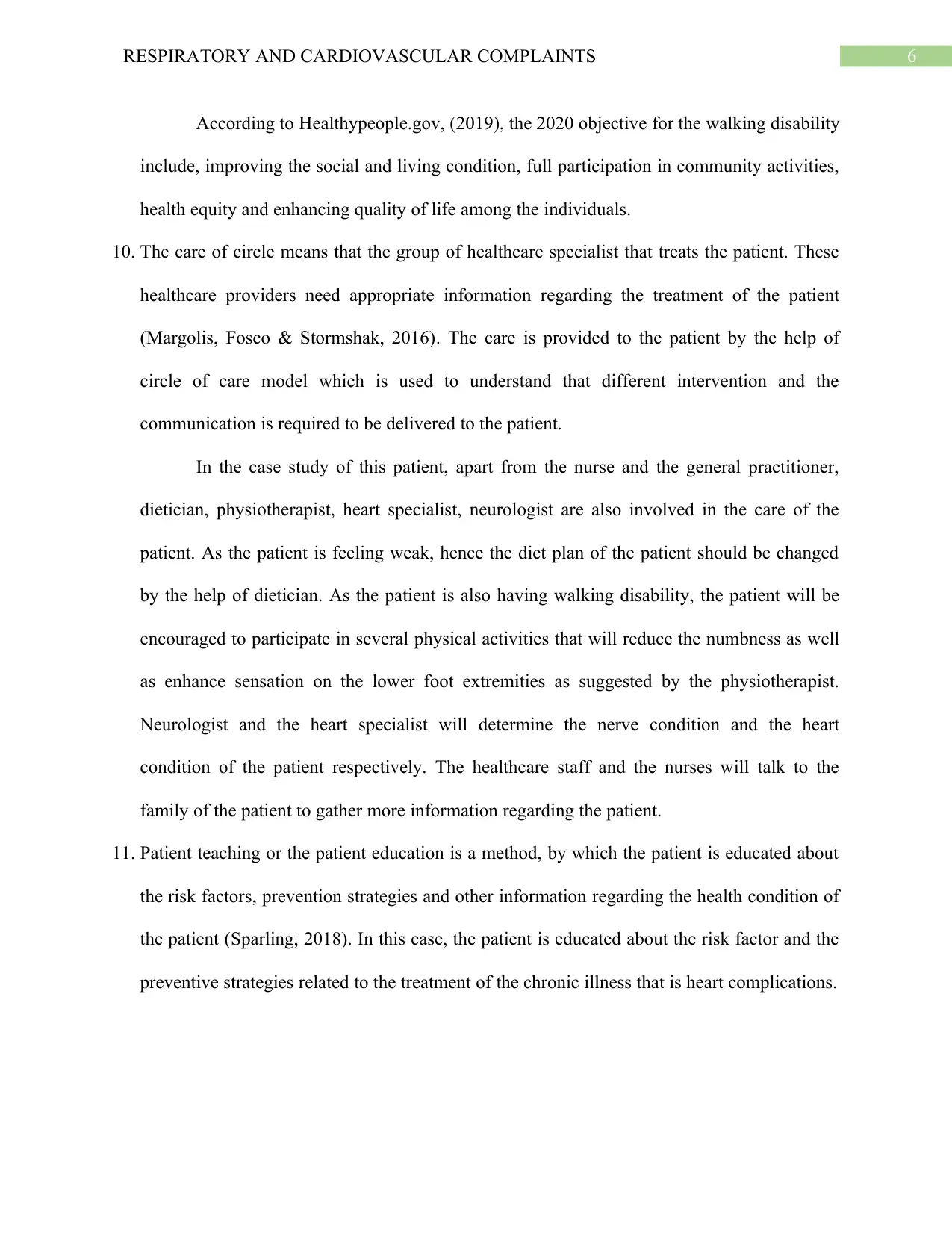
6RESPIRATORY AND CARDIOVASCULAR COMPLAINTS
According to Healthypeople.gov, (2019), the 2020 objective for the walking disability
include, improving the social and living condition, full participation in community activities,
health equity and enhancing quality of life among the individuals.
10. The care of circle means that the group of healthcare specialist that treats the patient. These
healthcare providers need appropriate information regarding the treatment of the patient
(Margolis, Fosco & Stormshak, 2016). The care is provided to the patient by the help of
circle of care model which is used to understand that different intervention and the
communication is required to be delivered to the patient.
In the case study of this patient, apart from the nurse and the general practitioner,
dietician, physiotherapist, heart specialist, neurologist are also involved in the care of the
patient. As the patient is feeling weak, hence the diet plan of the patient should be changed
by the help of dietician. As the patient is also having walking disability, the patient will be
encouraged to participate in several physical activities that will reduce the numbness as well
as enhance sensation on the lower foot extremities as suggested by the physiotherapist.
Neurologist and the heart specialist will determine the nerve condition and the heart
condition of the patient respectively. The healthcare staff and the nurses will talk to the
family of the patient to gather more information regarding the patient.
11. Patient teaching or the patient education is a method, by which the patient is educated about
the risk factors, prevention strategies and other information regarding the health condition of
the patient (Sparling, 2018). In this case, the patient is educated about the risk factor and the
preventive strategies related to the treatment of the chronic illness that is heart complications.
According to Healthypeople.gov, (2019), the 2020 objective for the walking disability
include, improving the social and living condition, full participation in community activities,
health equity and enhancing quality of life among the individuals.
10. The care of circle means that the group of healthcare specialist that treats the patient. These
healthcare providers need appropriate information regarding the treatment of the patient
(Margolis, Fosco & Stormshak, 2016). The care is provided to the patient by the help of
circle of care model which is used to understand that different intervention and the
communication is required to be delivered to the patient.
In the case study of this patient, apart from the nurse and the general practitioner,
dietician, physiotherapist, heart specialist, neurologist are also involved in the care of the
patient. As the patient is feeling weak, hence the diet plan of the patient should be changed
by the help of dietician. As the patient is also having walking disability, the patient will be
encouraged to participate in several physical activities that will reduce the numbness as well
as enhance sensation on the lower foot extremities as suggested by the physiotherapist.
Neurologist and the heart specialist will determine the nerve condition and the heart
condition of the patient respectively. The healthcare staff and the nurses will talk to the
family of the patient to gather more information regarding the patient.
11. Patient teaching or the patient education is a method, by which the patient is educated about
the risk factors, prevention strategies and other information regarding the health condition of
the patient (Sparling, 2018). In this case, the patient is educated about the risk factor and the
preventive strategies related to the treatment of the chronic illness that is heart complications.
Paraphrase This Document
Need a fresh take? Get an instant paraphrase of this document with our AI Paraphraser
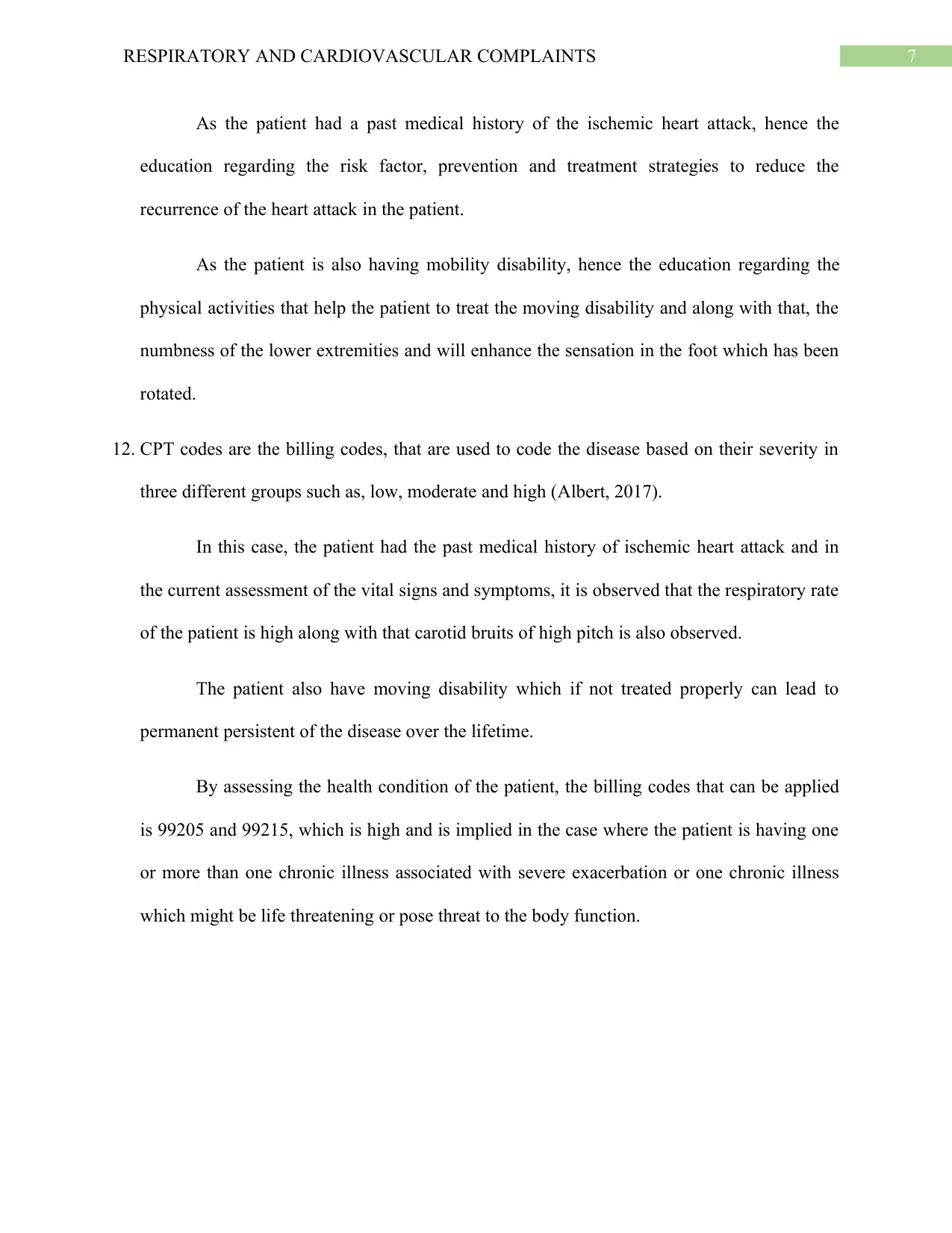
7RESPIRATORY AND CARDIOVASCULAR COMPLAINTS
As the patient had a past medical history of the ischemic heart attack, hence the
education regarding the risk factor, prevention and treatment strategies to reduce the
recurrence of the heart attack in the patient.
As the patient is also having mobility disability, hence the education regarding the
physical activities that help the patient to treat the moving disability and along with that, the
numbness of the lower extremities and will enhance the sensation in the foot which has been
rotated.
12. CPT codes are the billing codes, that are used to code the disease based on their severity in
three different groups such as, low, moderate and high (Albert, 2017).
In this case, the patient had the past medical history of ischemic heart attack and in
the current assessment of the vital signs and symptoms, it is observed that the respiratory rate
of the patient is high along with that carotid bruits of high pitch is also observed.
The patient also have moving disability which if not treated properly can lead to
permanent persistent of the disease over the lifetime.
By assessing the health condition of the patient, the billing codes that can be applied
is 99205 and 99215, which is high and is implied in the case where the patient is having one
or more than one chronic illness associated with severe exacerbation or one chronic illness
which might be life threatening or pose threat to the body function.
As the patient had a past medical history of the ischemic heart attack, hence the
education regarding the risk factor, prevention and treatment strategies to reduce the
recurrence of the heart attack in the patient.
As the patient is also having mobility disability, hence the education regarding the
physical activities that help the patient to treat the moving disability and along with that, the
numbness of the lower extremities and will enhance the sensation in the foot which has been
rotated.
12. CPT codes are the billing codes, that are used to code the disease based on their severity in
three different groups such as, low, moderate and high (Albert, 2017).
In this case, the patient had the past medical history of ischemic heart attack and in
the current assessment of the vital signs and symptoms, it is observed that the respiratory rate
of the patient is high along with that carotid bruits of high pitch is also observed.
The patient also have moving disability which if not treated properly can lead to
permanent persistent of the disease over the lifetime.
By assessing the health condition of the patient, the billing codes that can be applied
is 99205 and 99215, which is high and is implied in the case where the patient is having one
or more than one chronic illness associated with severe exacerbation or one chronic illness
which might be life threatening or pose threat to the body function.
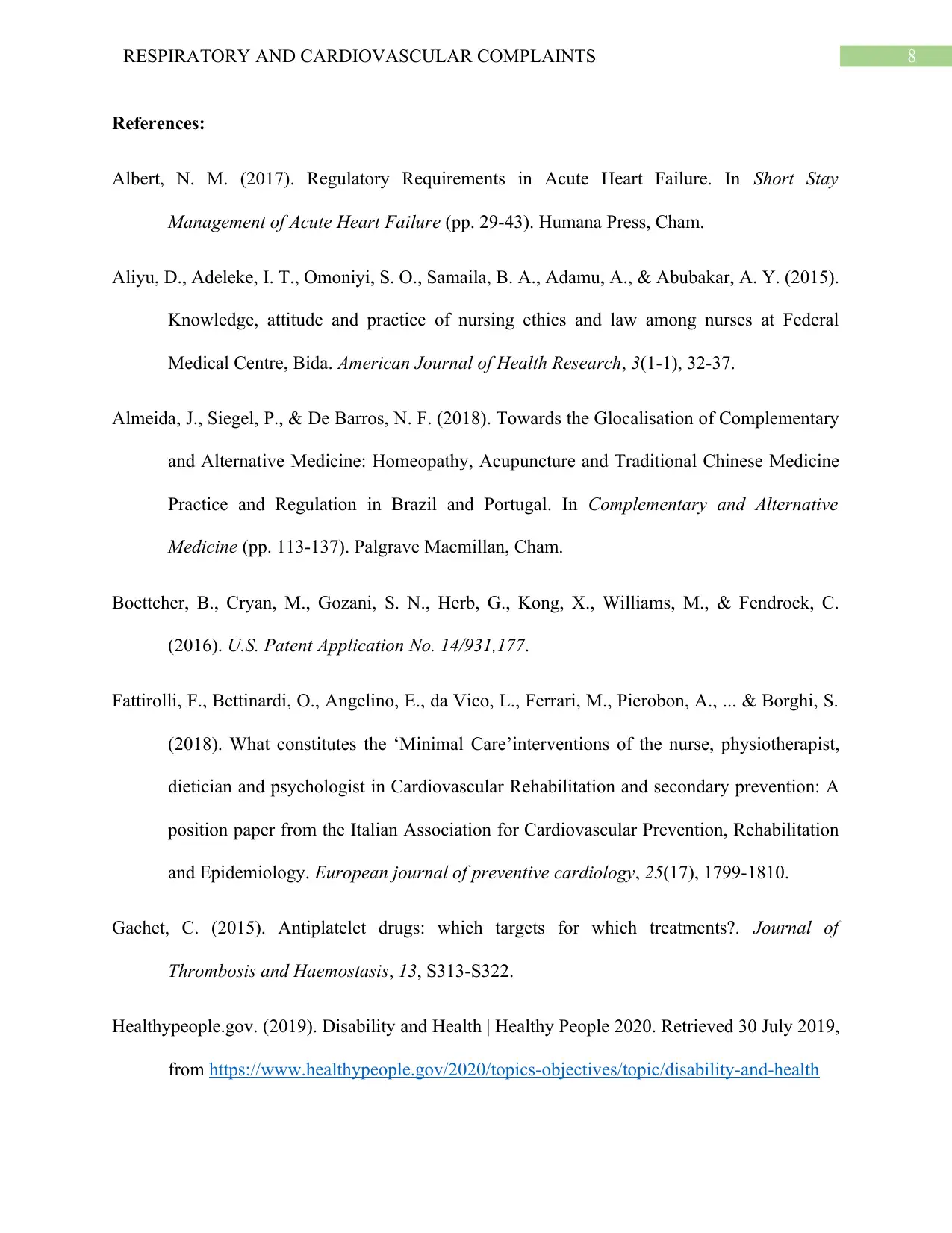
8RESPIRATORY AND CARDIOVASCULAR COMPLAINTS
References:
Albert, N. M. (2017). Regulatory Requirements in Acute Heart Failure. In Short Stay
Management of Acute Heart Failure (pp. 29-43). Humana Press, Cham.
Aliyu, D., Adeleke, I. T., Omoniyi, S. O., Samaila, B. A., Adamu, A., & Abubakar, A. Y. (2015).
Knowledge, attitude and practice of nursing ethics and law among nurses at Federal
Medical Centre, Bida. American Journal of Health Research, 3(1-1), 32-37.
Almeida, J., Siegel, P., & De Barros, N. F. (2018). Towards the Glocalisation of Complementary
and Alternative Medicine: Homeopathy, Acupuncture and Traditional Chinese Medicine
Practice and Regulation in Brazil and Portugal. In Complementary and Alternative
Medicine (pp. 113-137). Palgrave Macmillan, Cham.
Boettcher, B., Cryan, M., Gozani, S. N., Herb, G., Kong, X., Williams, M., & Fendrock, C.
(2016). U.S. Patent Application No. 14/931,177.
Fattirolli, F., Bettinardi, O., Angelino, E., da Vico, L., Ferrari, M., Pierobon, A., ... & Borghi, S.
(2018). What constitutes the ‘Minimal Care’interventions of the nurse, physiotherapist,
dietician and psychologist in Cardiovascular Rehabilitation and secondary prevention: A
position paper from the Italian Association for Cardiovascular Prevention, Rehabilitation
and Epidemiology. European journal of preventive cardiology, 25(17), 1799-1810.
Gachet, C. (2015). Antiplatelet drugs: which targets for which treatments?. Journal of
Thrombosis and Haemostasis, 13, S313-S322.
Healthypeople.gov. (2019). Disability and Health | Healthy People 2020. Retrieved 30 July 2019,
from https://www.healthypeople.gov/2020/topics-objectives/topic/disability-and-health
References:
Albert, N. M. (2017). Regulatory Requirements in Acute Heart Failure. In Short Stay
Management of Acute Heart Failure (pp. 29-43). Humana Press, Cham.
Aliyu, D., Adeleke, I. T., Omoniyi, S. O., Samaila, B. A., Adamu, A., & Abubakar, A. Y. (2015).
Knowledge, attitude and practice of nursing ethics and law among nurses at Federal
Medical Centre, Bida. American Journal of Health Research, 3(1-1), 32-37.
Almeida, J., Siegel, P., & De Barros, N. F. (2018). Towards the Glocalisation of Complementary
and Alternative Medicine: Homeopathy, Acupuncture and Traditional Chinese Medicine
Practice and Regulation in Brazil and Portugal. In Complementary and Alternative
Medicine (pp. 113-137). Palgrave Macmillan, Cham.
Boettcher, B., Cryan, M., Gozani, S. N., Herb, G., Kong, X., Williams, M., & Fendrock, C.
(2016). U.S. Patent Application No. 14/931,177.
Fattirolli, F., Bettinardi, O., Angelino, E., da Vico, L., Ferrari, M., Pierobon, A., ... & Borghi, S.
(2018). What constitutes the ‘Minimal Care’interventions of the nurse, physiotherapist,
dietician and psychologist in Cardiovascular Rehabilitation and secondary prevention: A
position paper from the Italian Association for Cardiovascular Prevention, Rehabilitation
and Epidemiology. European journal of preventive cardiology, 25(17), 1799-1810.
Gachet, C. (2015). Antiplatelet drugs: which targets for which treatments?. Journal of
Thrombosis and Haemostasis, 13, S313-S322.
Healthypeople.gov. (2019). Disability and Health | Healthy People 2020. Retrieved 30 July 2019,
from https://www.healthypeople.gov/2020/topics-objectives/topic/disability-and-health
⊘ This is a preview!⊘
Do you want full access?
Subscribe today to unlock all pages.

Trusted by 1+ million students worldwide
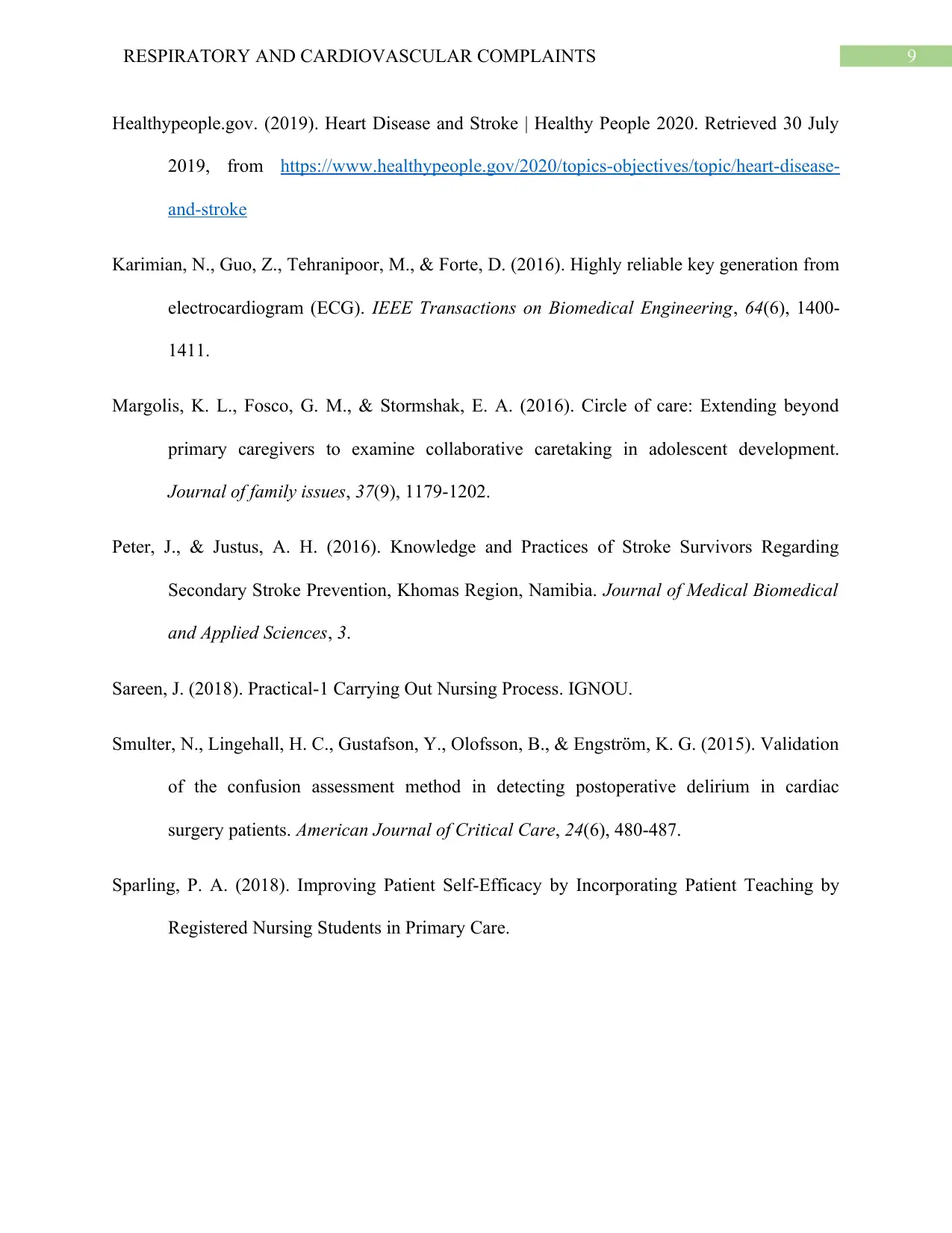
9RESPIRATORY AND CARDIOVASCULAR COMPLAINTS
Healthypeople.gov. (2019). Heart Disease and Stroke | Healthy People 2020. Retrieved 30 July
2019, from https://www.healthypeople.gov/2020/topics-objectives/topic/heart-disease-
and-stroke
Karimian, N., Guo, Z., Tehranipoor, M., & Forte, D. (2016). Highly reliable key generation from
electrocardiogram (ECG). IEEE Transactions on Biomedical Engineering, 64(6), 1400-
1411.
Margolis, K. L., Fosco, G. M., & Stormshak, E. A. (2016). Circle of care: Extending beyond
primary caregivers to examine collaborative caretaking in adolescent development.
Journal of family issues, 37(9), 1179-1202.
Peter, J., & Justus, A. H. (2016). Knowledge and Practices of Stroke Survivors Regarding
Secondary Stroke Prevention, Khomas Region, Namibia. Journal of Medical Biomedical
and Applied Sciences, 3.
Sareen, J. (2018). Practical-1 Carrying Out Nursing Process. IGNOU.
Smulter, N., Lingehall, H. C., Gustafson, Y., Olofsson, B., & Engström, K. G. (2015). Validation
of the confusion assessment method in detecting postoperative delirium in cardiac
surgery patients. American Journal of Critical Care, 24(6), 480-487.
Sparling, P. A. (2018). Improving Patient Self-Efficacy by Incorporating Patient Teaching by
Registered Nursing Students in Primary Care.
Healthypeople.gov. (2019). Heart Disease and Stroke | Healthy People 2020. Retrieved 30 July
2019, from https://www.healthypeople.gov/2020/topics-objectives/topic/heart-disease-
and-stroke
Karimian, N., Guo, Z., Tehranipoor, M., & Forte, D. (2016). Highly reliable key generation from
electrocardiogram (ECG). IEEE Transactions on Biomedical Engineering, 64(6), 1400-
1411.
Margolis, K. L., Fosco, G. M., & Stormshak, E. A. (2016). Circle of care: Extending beyond
primary caregivers to examine collaborative caretaking in adolescent development.
Journal of family issues, 37(9), 1179-1202.
Peter, J., & Justus, A. H. (2016). Knowledge and Practices of Stroke Survivors Regarding
Secondary Stroke Prevention, Khomas Region, Namibia. Journal of Medical Biomedical
and Applied Sciences, 3.
Sareen, J. (2018). Practical-1 Carrying Out Nursing Process. IGNOU.
Smulter, N., Lingehall, H. C., Gustafson, Y., Olofsson, B., & Engström, K. G. (2015). Validation
of the confusion assessment method in detecting postoperative delirium in cardiac
surgery patients. American Journal of Critical Care, 24(6), 480-487.
Sparling, P. A. (2018). Improving Patient Self-Efficacy by Incorporating Patient Teaching by
Registered Nursing Students in Primary Care.
Paraphrase This Document
Need a fresh take? Get an instant paraphrase of this document with our AI Paraphraser

10RESPIRATORY AND CARDIOVASCULAR COMPLAINTS
1 out of 11
Related Documents
Your All-in-One AI-Powered Toolkit for Academic Success.
+13062052269
info@desklib.com
Available 24*7 on WhatsApp / Email
![[object Object]](/_next/static/media/star-bottom.7253800d.svg)
Unlock your academic potential
Copyright © 2020–2025 A2Z Services. All Rights Reserved. Developed and managed by ZUCOL.





